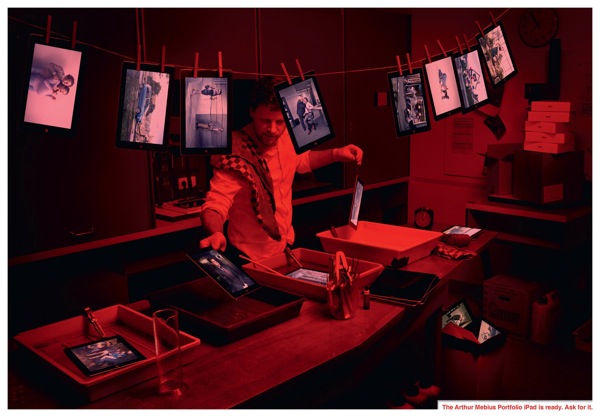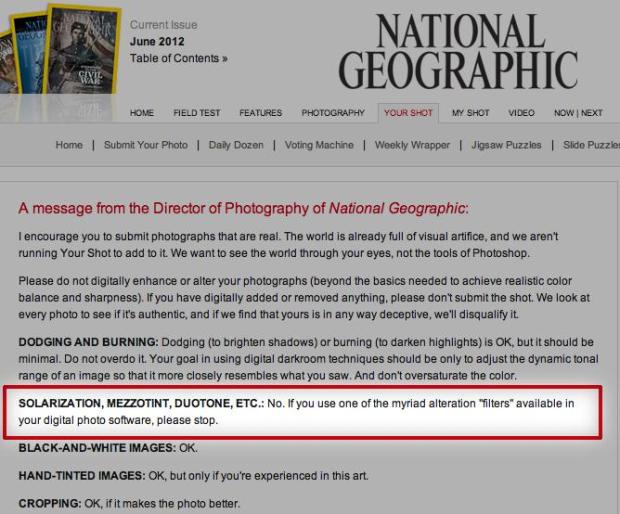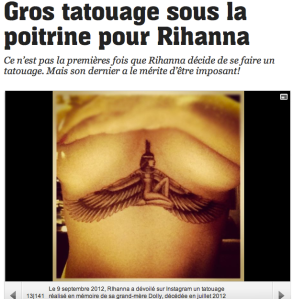Posts Tagged new technologies
Instagram: a teen-toy or the new reporter tool?
Posted by leagloor in Technology on November 26, 2012
“Instagram photos cheat the viewer!” Nick Stern’s claim, published in February 2012 on cnn.com, came as a bombshell, engendering pros and cons-reactions in the journalism and photo-reporting world. Who’s right? Let’s have a look!
With more than 30 millions of users and about 150 photographs posted (see article on Wikipedia), the photo-editing and social-networking app Instagram can be described as one of the most successful Smartphone tools. Among its users; teenagers, adults, singers, actors, politicians and, of course, journalists!
Yet the journalistic use of Instagram in a professional perspective has created a huge debate on the web since last February. The vexed question: can journalists and photojournalists honestly use Instagram as a professional tool, to cover a war or a political meeting, or has it to remain a “toy” only good to post pictures of your breakfast or your new nail-art?
 |
Cheating with reality?
For some photographers no hesitation, Instagram has nothing to do with information and journalism. Here are some of their main arguments. But before, here you go with a video that shows you how Instagram works and what are its main features:
Filters and fake emotions
Photographs bring emotion, related to the subject, to the viewer’s history but also thanks to the way the picture is taken. Regarding this, the anti-Instagramers are clear: Instagram kills the authenticity, creativity and originality of your pictures.
For Nick Stern (see the complete article here and his website here), American news photographer and first anti-Instagram pamphleteer, the pictures taken with the app do not communicate real emotions, conveyed by the photographer, as it should. “It’s the work of an app designer in Palo Alto who decided that a nice shallow focus and dark faded border would bring out the best in the image”, he claims, “The image never existed in any other place than the eye of the app developer”.
“The greatest photographs are created in the mind of the photographer and not in the workings of the camera.” Nick Stern
Moreover, with 14 different filters, the variety of pictures is indeed quite large however rather limited. According to its accusers, Instagram creates therefore photographic standards, which enchain the users, kill their creativity and prevent them from expressing their emotions.
But was it not already the case with silver films? Indeed, during the development process, the photographer could use different chemical techniques such as cross-processing and could therefore add something external to the picture.
Aesthetics against information duty
Showing reality objectively is one of the main goals of any journalists. For the anti-Instagramers, using an app that adds effects on a picture in order to make it look fancier or nicer does not fit the profession ethics. That is why Nick Stern says that “Every time a news organization uses a Hipstamatic or Instagram-style picture in a news report, they are cheating us all”.
However aesthetics is a part of photography anyway such as subjectivity. Photographers are dealing with image and cannot completely distance themselves from the visual dimension of their job.
As Joerg Colberg, an American photographer says “We all know that all photography is fiction: as a photographer you make choices, which influence the photograph enough for it to be more of a fiction than a fact. […] But the photojournalist’s task, no actually the photojournalist’s duty is to minimize the amount of fiction that enters her/his photography. […] The problem with InstaHip in this particular context is it adds a huge amount of fiction to photography, simply by its aesthetic” (see the complete article here).
News Trivialisation
Another problem raised by the accusers is that the majority of the Instagram pictures deal with the users’ every day life: meals, hobbies, fashion, cosmetics, friends, family and pets. Mixing serious news pictures with these trivial subjects minimizes their value and their informational impact.
“Since in the dominant context, people’s social lives, InstaHip photographs are usually not seen as particularly relevant, once you use InstaHip as a photojournalist you’re applying that same kind of thinking to your images. You’re trivializing your message.” Joerg Colberg
Why so unserious?
Maybe the solution would be to create a parallel network, which would share the same technical features and would be exclusively destined to news companies, a kind of Infostagram! But we will come back to that later.
The Like button tyranny
As other social networks, Instagram allows the users to share their pictures on other social medias such as Facebook and Twitter and proposes a comment option and a Like button.
American panelists wondered to which extent “Instagram’s Like button, combined with the image filters, has turned the service into performance art, with people trying to rack up Likes for the most aesthetically striking images” explains Steve Myers in his article on Instagram (see the complete article here). A sort of photographic social desirability!
As we will see later, these social network features can also be positive for journalists. In the mean time, to read more about the Like-culture problematic, click here.
Vintage overdose
You can see it in fashion: vintage is trendy! And photography is no exception to the rule. Instagram, with its Instamatic and Polaroid-inspired effect perfectly incarnates this trend (see this article here). But as Jean Cocteau said “Fashion is what goes out of fashion.” Thus, the risk that Instagram becomes outmoded is real.
What risk for journalism then? Since Instagram becomes has-been, the information broadcasted on it will not be seen as relevant by its users or its ex-users. The value of information will be at stake.
Moreover, is not information supposed to be related to the here and now, to the burning issues and not focused on the past?
 Instamatic Kodak 100, 1963 |
 Polaroid One Step, ’80 |
Connecting people?
Does Instagram look like the Devil to you now? Fortunately some positive and helpful aspects can also be highlighted, all related to the social dimension of the app.
Information network
As already said, Instagram is not only a photo-editing app, it also allows the user to create an extended network, to follow people and to get followers. Videos on Youtube actually show you how to be followed by the maximum of users. Do you remember what we have said about the Like button tyranny?
More seriously Instagram can become a real information feed, through the channels of news companies or through the topics dealt with on the official blog of the app (see here). However, at the moment, the media channels remain extremely poor and unfed. The only one which seems active is the CNN’s, perhaps because of its US origin and destination. Here are some examples taken from Webstagram, the Internet viewer of the app.
One of the rare successful examples of use is the covering of the New York Fashion Week 2012 by the New York Times. The journalists present on the site provided 450 pictures through the account created for this occasion, visible here. With 156’319 followers, the operation was a real success.
 |
 |
Another example: the National Geographic launched a blog fed with climbers’ Instagram pictures called “Field test – On Everest”. The Instagram feed of the magazine, visible here, is also well provided with pictures.
However the company seems less tolerant regarding the pictures sent by its readers. In a message on the company website, the photography director encouraged the National Geogrpahic readers to avoid sending them modified pictures:
This desire of authenticity and objectivity matches the cons arguments presented previously regarding Instagram.
The non-professional Keystone
If the National Geographic had a really ethical reaction regarding photography, this is not the case for some other medias. Indeed Instagram can be used as a kind of a non-professional Keystone.
Let’s think about several showbiz articles written by the 20minutes about Rihanna’s tattoo or Kim Kardashian’s look. The information comes directly from what the celebrities post on Instagram as a primary source. Even if we are talking about famous people, this is what we call crowdsourcing or UGC (User Generated Content).
In a more serious perspective, a new app has been developed, called “Signal”, a mix between Instagram and Foursquare. With this app, you can post pictures and geolocalize them.
Normal citizens and journalists will thus be able to get informed of the events happening in their country or their area. What happened with Twitter during the Arab Spring could also happen thanks to photographs (see complete article here).
Democratisation of photography
One of the main arguments against Nick Stern’s article was that his vision of photography was elitist. Let’s think about Mathew Ingram’s article (available here) who vividly criticizes this vision.
Likewise, the photographer and photography teacher Richard Koci Hernandez praises the new possibilities of interacting with the audience offered by Instagram: “More people are now being exposed to my journalism than ever before […] Now I have access to literally the entire world.” (see complete article here).
Thus, for Instagram-defenders, using this app is also a way to have access to a form of art production, which was by now saved for professionals and artists. But can we honestly put on the same level the technique required by an SLR camera manipulation and the use of a mobile phone?
A matter of perspective
As we have seen, no categorical answer to the Instagram problematic can be given. Asking what a relevant photograph or a worthy photographer should be requires also to ask what photography is. A hobby? A job? An art? The three of them? Maybe the answer lies in the context or the personal perspective in which the picture is taken.
Let’s think about Benjamin Lowy’s work in Afghanistan. He used Instagram but did not betray what the journalist Alex Garcia calls “the vision and mission of photojournalism – [he is] applying a creative aesthetic that adds meaning or accessibility to [his] images” (see complete article here).
Anyway we should not forget that, Instagram or not, photography is always a matter of choice. By then, watch the birdie!
By Lea Gloor
Tutorial: the use of social networks (Twitter and Facebook) as a journalist
Posted by guillaume35 in Entertainment, Technology on November 26, 2012
Both Twitter and Facebook cannot be ignored any more when talking about the World Wide Web. Thus are they surely to be considered when using the amazing internet tool as a journalist. Let’s now have a look at how to get the best of it!
Guillaume Laurent
The social networks, by the number of subscribers they gather, are a rich source of information, as well as an amazing showcase. Therefore, it can be used by journalists in a number of ways: to always be aware of what is going on and interesting people, to try to get people to give their opinion about a subject, to get some feedbacks about an article, or to extend one’s readership and number of followers. In the interest of being more accurate, I’ll focus here only on the use of Twitter and Facebook Here are the few tips you will need to be an efficient social network journalist!
Three things to know when using social networks as a source
1- Verification must without contest be your main concern when using social networks as a source. If social networks can often be much quicker than traditional Medias to provide a story, they cannot be trusted, and the journalist must look around to see if other users or legitimate sources providers can confirm the story.
2- You have to develop your own trusted network within social Medias. Getting the wider choice among a group of users you now are trustworthy is a powerful asset for a journalist using social networks.
3- You must be systematic when using social Medias as a source. By doing the same ritual times and times again, you will gain a more accurate judgment about what is said on social networks, and thereafter win a lot in efficiency.
Three things to know when using social networks to gather opinions
1- Think about your personal experience on social networks. In which circumstances would you give your opinion? Which kind of question would you actually answer and which kind you wouldn’t? It will give you a valuable clue to guess how to manage your audience and get the best of it.
2- Before looking after opinions, you have to decide if you want to get a number based statistic answer or rather a few interesting witnesses. You will get more answers with a question that can be answered only by “yes” or “no”, but an open question will often give you more information to deal with.
3- Create a debate. To give their opinion about a specific subject, people must feel concerned, disturbed, annoyed or enthusiasm. Therefore you should give a direction to your question, give something of yourself to push your followers to react. .
Three things to know when using social networks to get some feedbacks about one’s articles
1- Getting a lot of feedbacks can be dangerous for your website. If you want to advertise using social networks you will have to be ready to assume de consequences. I mean managing properly de comments posted on your page or website. Otherwise, spamming or provocative answers will quickly suffocate the debate.
2- Before advertising on social networks, you must be aware that everything you will post, included answers to readers, comments or random posts, will be considered as a part of your work and evaluated and criticize in this sense. There for having separates account for your private life and your job can be very useful.
3- Post pictures and videos to get attention. Even if your work is mainly based on writing, you will have to use pictures and videos. It will surely get you more feedback, and images are what modern internet journalism is all about.
Three things to know when using social networks to extend one’s readership
1- “Tweet your beat”, the advice was given by Lauren Invik, from the social medias specialized website marshable.com. If you want to get some authority on social networks and bring in something more than the millions of other users, you have to be a specialist. That means tweeting or publishing on Facebook only when you know exactly what you are talking about. Giving your opinion on random subjects is not a plan for a good social networks journalist.

2- Being a specialist also includes being among the first to get the news about your favorite subject. Therefore is it necessary to give to your audience more than your own stories. Using in a wise way the retweet or share opportunity will help you a lot while trying to please your followers and make your account attractive.
3- Link as much as possible your publications. The hashtag and the “@” button are crucial not only to reach a wider public, but also to show your sources and make your information safe and valuable. Websites like tagboard.com are based on the use of the “@” and de hashtag and often used by people to look for news about a specific subject.
So, fellow journalists, have you already been using successfully social Medias in your work? Would you add some advices to the previous shortlist? This article is meant to be updated and enhanced by your contribution!
To become a perfect social Media journalist: more advices with this Youtube vidéo from BeatBlogging.Org
More on the subject with this France 2 TV show about Twitter brodcasted in 2010
God bless the Indignant
Posted by violetaferrer in People, Technology, Various on May 28, 2012
By Violeta Ferrer
May 15th : Puerta del Sol, citoyenne door
Reminder: On May 15th 2011, an “Indignant “Movement was born as a reaction to the European economic crisis. It’s a citizens’ movement, which aims to promote participatory democracy and a radical change of the neoliberal policies. The demonstrators are mainly young people, intellectuals and laymen who declare themselves independent of the control of political parties, unions, churches and mass media. “The Nonviolent Struggle in 50 points”: « La Lutte non-violente en 50 points »
A new tool of power: Their voice transcends borders. Social networks and blogs are their faithful allies to disseminate their ideas, organize demonstrations, share opinions and increasingly recruit indignant all around the world. A new freedom of opinion has arisen. Facebook and Twitter they are more than social networks, they became a multimedia platform: Photos, articles, opinions, videos, reporting, events’ organization,etc. Tools necessary for a Multimedia movement.
From August 15 to 21: GOD BLESS THE “INDIGNANT”:
The Antipope group and the “Indignant” movement pushed by the enthusiasm, euphoria and success of the manifestations in Spain and all over the world decided to protest against a supreme untouchable mystical power: The Pope Benedict XVI.
Medias : Euronews, 17 August 2011
Twitter : The Indignant
Twitter: The WYD
Madrid hosted the Pope during the World Youth Day (WYD). The Government considered the day as an exceptional event and of public interest. On the contrary, protesters were arguing that the arrival of the Pope was a demonstration of supranational power/influence. Their unhappiness was fed by the enormous costs of the event, in a context of severe economic crisis. WYD is definitely too pompous, too expensive: For a week, between 50 and 60 million € were spent. A million of young religious people with different ideas than the “Indignant” attended the event. According to the citizen movement, the Pope’s visit should have been less luxurious and pompous:
Organizers defended themselves by proving that the budget has decreased by 20% in comparison to the budget of 2008 in Australia, and participants funded about 80%. Only the authorities and Catholic associations or private companies would finance the remaining 20%. In a time of deep crisis, the Pope’s arrival in Madrid was a major event broadcasted by media around the world.
The face to face/ confrontation:
It was lost by the “Indignant”, considered that they were only a few hundred protesters against more than 2,000 million pilgrims. Postures and religious ideas were confronted openly in the streets of the Spanish capital. “Indignant” did not have any other choice than to give up and become “indignant” at home and on social networks as the city, previously held by them, was now the city of Jesus’ followers.
As expected the event caused several damages, some wounds and arrests. The police violence against demonstrators was highlighted on traditional media and social networks:
See you in Rio de Janeiro (Brazil) in 2013: The 2013 WYD is already mobilizing on Facebook and Twitter.
For years, religious groups have been using new technologies of communication and information to reach new generations. The proof is on Facebook: 102’432 persons are already registered to the WYD page, at 423 days of the event.
If you are an atheist, in a minute you will be convinced to convert to the Catholic Church: watch this publicity!
WYD – Catholic youth answer to laic, atheist, against pope, protest at Madrid, Spain:
On the other hand, if you would like to understand why the capitalism is broken watch this video: “Story of stuff, Full Version; How Things Work, About Stuff”
In conclusion, by analyzing the events of August 2011 in Spain, we confirmed that the new generation, conservative or liberal, are using new technologies to claim their ideologies and postures. This is the true revolution of youth.
To be continued…
Do you agree with the “Indignant “or the Catholic youth? What is your opinion on Pope Benedict XVI?
Your opinion matters: Write it here !
New Journalism: Online Journalism
Posted by violetaferrer in Technology on January 5, 2012
How we can defined the online journalisme?
When we speak of Online-journalism we find ourselves faced with a complex problem of definition: are we talking about of a new journalism, with features, players, rules, processes and new ethical charts? Or it is just a new tool for traditional media, which use these tools as distribution channel? Even more, it is a professional journalism, citizen journalism, or a mixture of both?
We conducted a survey of Online- French media.

Initially the traditional media only translated their information online. Then they realized that their audience was not happy to be just a consumer of information and wanted to be positioned as citizen entitled to participate actively in the creation of public opinion, in order to assert the fundamental right to the freedom of speech.
The major advantages of the Internet: responsiveness and citizen participation
Internet is thus converted to a carrier that provides information, follows the news, and most importantly it provides responsiveness and citizen participation. That is why traditional media on the internet such as Le Monde, TSR, RSR include on their website a space for comments, blogs, and are linked to social network such as Facebook, Twitter, RSS. In that way, they can respond quickly by providing scalable information, which are constantly enriched.
Can we talk of citizen participation in the new online media? Listen to the conference of the founder of exciting online journal Medipart, Edwy Plenel. Another good reference can be the following interview of the journalists Gille Klein and Alain Joannès
Some journalists from traditional media have realized that this new technology has its place in the economic market of the media, labour, and creativity. Thus was born the Online Journalism. A citizen journalism and/or professional using this technology as main support for the dissemination of information and opinions. Since the beginning, professional journalism online has had hard time to be recognized as qualified journalism. But there are some examples
The Online-TV: Quality, thematic information and participation
There are different formulas in the creation of online TV: On the one hand, those made by professionals and found in traditional television channels, and the Internet. On the other hand, those broadcasted only on the WEB. Most of online TV are thematic and have a public target: @rrêt sur images: critical issues on the media, Terretv, reportages on environment, carrefourstv, reportages and news on multiculturalism, universciencetv, scientific, WEB TV Geneva, the news from Geneva, Télé Libre.fr, a citizen media: independent and participatory created by professionals and amateurs. Here WEB TV program: you will find the program of WEBTV by theme. www.programme-webtv.com
The Free TV is funded primarily by contributions from citizens. This is not the only media on the Internet that is financed primarily on citizen input. In fact this formula is largely found in any media disseminated primarily or solely on the Internet. This contribution is also seen as a commitment of citizens to freedom of speech, independence and support to quality journalism. In other words, you people, you defend the freedom of speech on the Internet, so you have to contribute financially too…
Online – Press: More and more
The website J’aime l’info is just a platform for donations for the online press, to appeal to citizens to participate with their economic contribution to the development of quality digital press. It is a database to find the major online newspapers. The platform is managed by the Union of the independent press information online (le Syndicat de la presse indépendante d’information en ligne)(Spiil).
The French press is the media which has more developed their concept of Online Media. Numerous newspapers, magazines, weekly have been created; information channels by young journalists such as zoomdici.fr, magazines for specific thematic such as equality between men and women www.egalite-infos.fr, independent newspapers such as Rue89 or Médiapart, a news digital, independent and participatory.
The Online – Radio:
Find professional digital radio is a challenge. Most traditional radio stations are broadcasted on the air and on website. The radio broadcasted only on the Web are created and developed by amateurs who find in this medium a mixture of information and entertainment accessible and manageable. Radionomy is a platform collecting francophone web radios, and allows you to create your own for free, but only as an amateur radio.
Radio Euro District: The exception makes the rule. Web radio, which transcends borders and provides news content and quality entertainment in two languages: French and German. This radio is managed by a journalist with over 20 years experiences.
The difficult use of the freedom of choice:
We see an evolution of the media; they allow citizens and professional journalists to create their own media on the Internet. But it is difficult to choose among the different media, to know whether or not their content is reliable, if their realization is professional, or if they are credible sources. Finally, consumers have several choices, but what to choose? What can be trusted? This is the new challenge.
Do you know any web-quality media? Do you participate in an Online-media? Young journalists, do you be a journalist-Online. Tell us your experience!!
Violeta Ferrer






























